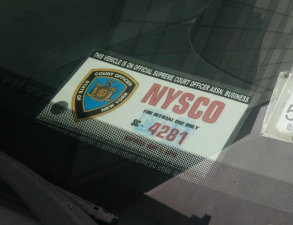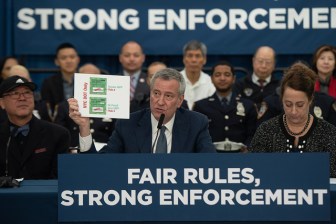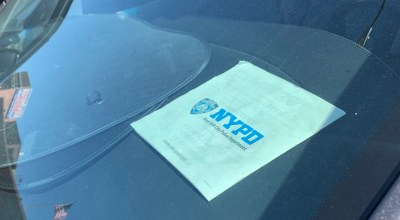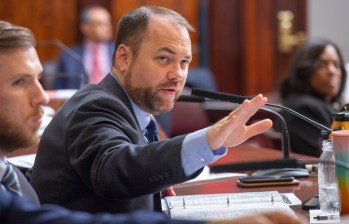EXCLUSIVE: Council Speaker Corey Johnson Will Push de Blasio on Placard Abuse This Week
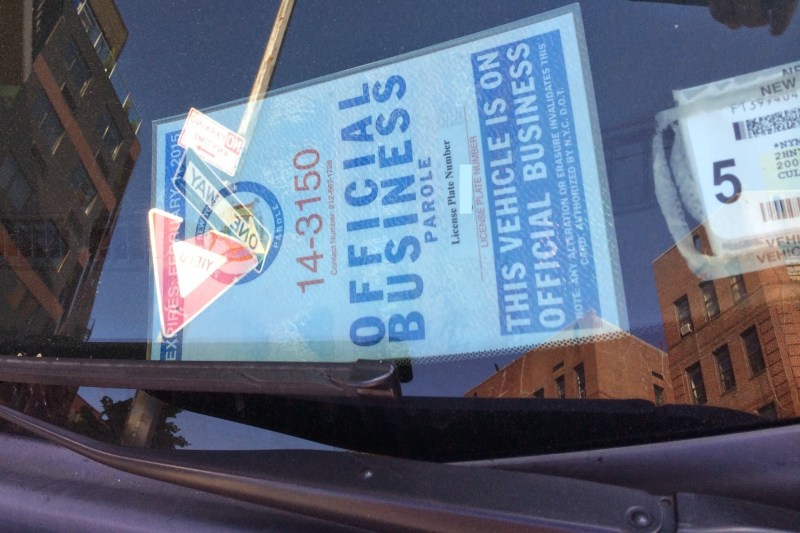
The City Council, led by Speaker Corey Johnson, will unveil a slate of legislation this week to root out placard corruption and the street chaos it causes, Streetsblog has learned — proving again that the only bill that’s missing in action on illegal parking is named de Blasio.
One of the five new bills, co-sponsored by Johnson and Council Member Keith Powers, would create a singular application process, and accountability, for parking permits. Another, co-sponsored with Ritchie Torres, would require at NYPD traffic agents to conduct at least 50 “targeted enforcement sweeps” per week, monitored by the Department of Investigations and based on 311 complaints.
“Placard abuse is corruption, plain and simple, and New York City cannot tolerate it any longer,” Johnson told Streetsblog.
The mayor has tolerated it — and, in fact, expanded it. Over 150,000 placards are currently in circulation, up at least 50,000 since de Blasio took over, allowing entitled government employees to evade penalties for illegal and dangerous parking in crosswalks, on sidewalks, in bike lanes, and next to bus stops. They get away with it because NYPD traffic agents are loath to ticket their fellow municipal employees (and fellow cops!).
The driver of this Mercedes had a new 2020 #bribeacop #fakeplacard from @ThePBA, and wasted no time using it to park illegally.#placardcorruption pic.twitter.com/HcIPY0a1O5
— placard corruption (@placardabuse) February 11, 2019
Parking rules may seem trivial to the larger problem of congestion and failing transit, but 150,000 legal scofflaws, plus the uncounted forged placards, create a culture of disregard that becomes a “gateway drug” to further corruption, as the Daily News’s Errol Louis recently put it. Placards are also easy to forge — though a tracking system is also part of the council slate.
“Placard abuse has become the norm throughout many neighborhoods, including on the already heavily congested streets of Lower Manhattan, particularly in Chinatown and Battery Park City,” said Council Member Margaret Chin, whose district is overrun with scofflaw parking and has already proposed legislation to revoke placards for misuse. “We cannot allow the status quo to continue if we are to ensure the safety of our streets for pedestrians and the general public.”
The other new bills would require that the city’s 311 system accept complaints related to illegal parking and placard abuse, which it currently does not; and require that enforcement agents notify city tow units to remove any vehicles illegally blocking bike lanes, bus lanes, crosswalks, sidewalks, or fire hydrants.
And a final proposal is not without irony: it would make it illegal for city vehicles to block bike lanes, bus lanes, crosswalks, sidewalks, or fire hydrants — all of which are already illegal (not that you would know it from the streets around government buildings all over the city).
The bills aren’t the first from the Council aimed at addressing widespread placard abuse, but the de Blasio administration and NYPD have repeatedly opposed those proposals, which include common-sense bills that would require the NYPD to report on placard abuse and create a system to track misuse of placards.
In opposing the bills, the de Blasio administration said in May, 2017 that it had created a dedicated enforcement unit, but its impact has been negligible, as the watchdogs who manage the @placardabuse Twitter account have carefully documented.
And for months, de Blasio has been telling reporters that further news on placards is imminent. But so far, nothing.
The continued prevalence of parking placards and placard abuse is especially concerning as the city attempts to tackle growing congestion issues. City employees are less likely than the average New Yorker to own cars, but they are more likely to commute by car into Manhattan’s Central Business District, partly because of a guaranteed parking space near their office or school or stationhouse — a benefit worth hundreds if not thousands of dollars that is not currently taxed as income. Illegally parked placard cars also make deliveries more difficult.
“We are in a transportation crisis and the question of how we allocate our street space is of paramount importance,” Johnson said in his statement to Streetsblog.
For that reason, placard reform was one of the top-line recommendations of the MTA Sustainability Advisory Workgroup in December [PDF].
Ultimately, the only real solution would be a dramatic reduction in the number of placards issued by the city. But progress on that front during the Bloomberg administration has been mostly reversed under de Blasio, who in doled out 50,000 new placards to public school teachers two years ago.
